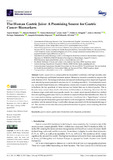Mostrar el registro sencillo del ítem
The human gastric juice: a promising source for gastric cancer biomarkers
| dc.creator | Felípez, Nayra | es_ES |
| dc.creator | Montori, Sheyla | es_ES |
| dc.creator | Mendizuri, Naroa | es_ES |
| dc.creator | Llach, Joan | es_ES |
| dc.creator | Delgado, Pedro G. | es_ES |
| dc.creator | Moreira, Leticia | es_ES |
| dc.creator | Santamaría, Enrique | es_ES |
| dc.creator | Fernández Irigoyen, Joaquín | es_ES |
| dc.creator | Albéniz Arbizu, Eduardo | es_ES |
| dc.date.accessioned | 2023-10-17T15:07:48Z | |
| dc.date.available | 2023-10-17T15:07:48Z | |
| dc.date.issued | 2023 | |
| dc.identifier.citation | Felípez, N., Montori, S., Mendizuri, N., Llach, J., Delgado, P. G., Moreira, L., Santamaría, E., Fernández-Irigoyen, J., Albéniz, E. (2023) The human gastric juice: a promising source for gastric cancer biomarkers. International Journal of Molecular Sciences, 24(11), 1-15. https://doi.org/10.3390/ijms24119131. | en |
| dc.identifier.issn | 1661-6596 | |
| dc.identifier.uri | https://hdl.handle.net/2454/46557 | |
| dc.description.abstract | Gastric cancer (GC) is a major public health problem worldwide, with high mortality rates due to late diagnosis and limited treatment options. Biomarker research is essential to improve the early detection of GC. Technological advances and research methodologies have improved diagnostic tools, identifying several potential biomarkers for GC, including microRNA, DNA methylation markers, and protein-based biomarkers. Although most studies have focused on identifying biomarkers in biofluids, the low specificity of these markers has limited their use in clinical practice. This is because many cancers share similar alterations and biomarkers, so obtaining them from the site of disease origin could yield more specific results. As a result, recent research efforts have shifted towards exploring gastric juice (GJ) as an alternative source for biomarker identification. Since GJ is a waste product during a gastroscopic examination, it could provide a “liquid biopsy” enriched with disease-specific biomarkers generated directly at the damaged site. Furthermore, as it contains secretions from the stomach lining, it could reflect changes associated with the developmental stage of GC. This narrative review describes some potential biomarkers for gastric cancer screening identified in gastric juice. | en |
| dc.description.sponsorship | This was supported by grants from Instituto de Salud Carlos III (PI21/00333 and PI21/01181). Nayra Felípez has a grant from Departamento de Universidad, Innovación y Transformación Digital. Gobierno de Navarra (Ref 0011-1408-2022-000010). | en |
| dc.format.mimetype | application/pdf | en |
| dc.language.iso | eng | en |
| dc.publisher | MDPI | en |
| dc.relation.ispartof | International Journal of Molecular Sciences 2023, 24(11), 9131 | en |
| dc.rights | © 2023 by the authors. Licensee MDPI, Basel, Switzerland. This article is an open access article distributed under the terms and conditions of the Creative Commons Attribution (CC BY) license. | en |
| dc.rights.uri | http://creativecommons.org/licenses/by/4.0/ | |
| dc.subject | Biomarker | en |
| dc.subject | Early diagnosis | en |
| dc.subject | Gastric cancer | en |
| dc.subject | Gastric juice | en |
| dc.subject | Proteomics | en |
| dc.title | The human gastric juice: a promising source for gastric cancer biomarkers | en |
| dc.type | Artículo / Artikulua | es |
| dc.type | info:eu-repo/semantics/article | en |
| dc.date.updated | 2023-10-17T14:45:41Z | |
| dc.contributor.department | Ciencias de la Salud | es_ES |
| dc.contributor.department | Osasun Zientziak | eu |
| dc.rights.accessRights | Acceso abierto / Sarbide irekia | es |
| dc.rights.accessRights | info:eu-repo/semantics/openAccess | en |
| dc.identifier.doi | 10.3390/ijms24119131 | |
| dc.relation.projectID | info:eu-repo/grantAgreement/ISCIII/Plan Estatal de Investigación Científica y Técnica y de Innovación 2017-2020 (ISCIII)/PI21%2F00333/ES/ | en |
| dc.relation.projectID | info:eu-repo/grantAgreement/ISCIII/Plan Estatal de Investigación Científica y Técnica y de Innovación 2017-2020 (ISCIII)/PI21%2F01181/ES/ | en |
| dc.relation.projectID | info:eu-repo/grantAgreement/Gobierno de Navarra//0011-1408-2022-000010 | en |
| dc.relation.publisherversion | https://doi.org/10.3390/ijms24119131 | |
| dc.type.version | Versión publicada / Argitaratu den bertsioa | es |
| dc.type.version | info:eu-repo/semantics/publishedVersion | en |



